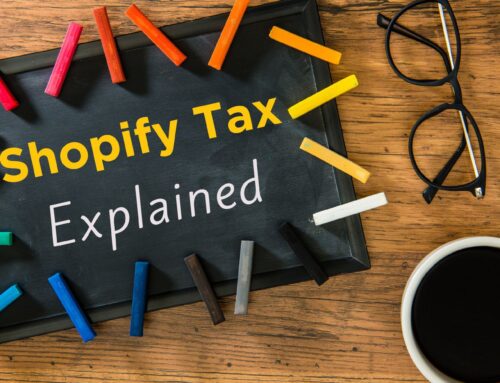
As a new Shopify seller, setting up your Shopify bookkeeping the right way is crucial. It can be daunting, though. Thinking about doing your books and tracking all your financials can make you want to throw in the towel (before you’ve even started). Shopify bookkeeping is not easy – even for professional bookkeepers. That’s why in this article, I’m giving you my top tips for setting up your Shopify bookkeeping the right way.
Click on the link below to watch: Tips for setting up your Shopify bookkeeping the right way
Tip # 1: Use QuickBooks Online
The software that I recommend for tracking your financials is QuickBooks Online. When choosing the version of QuickBooks Online that you want to use, you can use the Simple Start version or the Essentials version. There’s no need to overspend on the Plus or Advanced versions. Just start simple; if you need to upgrade, you can always do so later.
You can get discount on QuickBooks Online by using this affiliate link.
Tip # 2: Set up the Chart of Accounts correctly
The chart of accounts is the foundation of your books, and it dictates how you will be categorizing all of your transactions. That’s why you need to make sure that your chart of accounts is set up correctly.
When you’re setting up your books, you have to be able to reconcile the income that you will be recording to the deposits that you will be receiving from all of your payment processors. This means you have to make sure that you set up your clearing accounts. You can download my free Shopify Bookkeeping Blueprint, where I walk you through this process. I’ll also show you the accounts you need to set up that are specific to Shopify.
You can find even more information on customizing your Shopify chart of accounts in QuickBooks Online in this video.
Tip # 3: You can use integrations and automations to help save time
When it comes to integrations and and automations with QuickBooks Online and Shopify, there is a lot that we can do to tracking your financials. However, I hate to burst your bubble, but there is no such thing as “automagical” bookkeeping.
Yes, you can set all this up. Yes, it will save you some time. Yes, it will eliminate a lot of manual data entry. But it will not eliminate the need to do the books. You will still have to do your books or hire someone to help you to do your books.
Tip # 4: Beware of the ‘data dump’
Many Shopify sellers just go into the Shopify app store and find an app to sync QuickBooks with Shopify. Unfortunately, some of these apps just bring in a whole bunch of individual transactions.
Imagine that you have 100 sales in one day. You’ll be adding 100 transactions into QuickBooks, but you’ll have no way to reconcile those transactions with the amounts you’re receiving from Shopify, from PayPal, and from other payment processors. I call this the ‘data dump’. It’s when these apps send over transactions to QuickBooks, but there is no way to reconcile any of it. All it does is clutter up the books.
In short, be careful. The app that I recommend for integrating Shopify and QuickBooks is A2X. You can get the app by following this link. [For 20% off your first 6 months, you may use my affiliate code: 6MON20_VW when purchasing your subscription].
Tip # 5: Keep it simple when tracking inventory and Cost of Goods
Inventory and cost of goods is a fairly complex topic. Tracking inventory the correct way and getting a good cost of goods number can be very challenging.
As a new seller, you need to start simple, especially when it comes to managing your inventory. You have to start somewhere, and we can’t get too fancy adding a whole bunch of apps, since each process handled by an app requires extra time to maintain. I typically recommend that you just start tracking your inventory using a spreadsheet and then move toward using an inventory management app later on.
If you’d like to explore more on this topic, in this linked video, I discuss methods for tracking and managing your inventory.
Tip # 6: Sales Tax do’s and don’ts
Do’s: You need to register in the states where you have a physical presence (like your home state). You also need to understand the basics of sales taxes.
Don’ts: There’s no need to panic! Most new sellers don’t have to worry about collecting sales taxes in multiple states until they have economic nexus. So how do you know if you have economic nexus in a state? While every state is different, for many states, you have to meet their specific thresholds. (For example, it may be 100 transactions or $100,000 in sales).
So don’t worry, just get registered for and start collecting sales taxes in the state(s) where you have a physical presence, then keep an eye on the other states where you’re selling to see if you’re meeting their specific thresholds.
For more information, watch this linked video where I explain sales taxes in more detail.
Tip # 7: Learn everything you can about tracking your Shopify financials
This is one of my most important tips: Soak up all the knowledge you can get about tracking your Shopify financials! One easy way do that is to subscribe to my 5 Minute Bookkeeping YouTube channel and look for my playlist on e-commerce bookkeeping, where you can find lots of content on Shopify bookkeeping.
Tip # 8: Consider working with a professional
If getting this all set up the right way is really overwhelming for you, consider working with a professional to help you start out strong.
This is something that I do with new Shopify sellers. I help set up their books the right way – which means making sure that their QuickBooks Online is set up correctly, that the chart of accounts is ready to go, and that the integration between Shopify and QuickBooks is also set up properly. All this helps provide a solid foundation to get started on the right foot.
I also offer one-on-one coaching to help Shopify sellers understand the basics of what they need to do to maintain their books.
So, if you’re interested in having a professional help you get set up, that’s something I can help you with. To learn more about my services, and whether we would be a good fit to work together, simply follow this link to get more information.
Closing
Now that you’ve heard my top tips for setting up your Shopify bookkeeping the right way, I hope you feel encouraged that it is absolutely possible to get off to a great start. Just remember to take it one step at a time and to keep things as simple as possible. You’ve got this!
If you have any questions, come join my 5 Minute Bookkeeping Community on Facebook, where you can discuss Shopify bookkeeping with professionals and DIY-ers alike.




